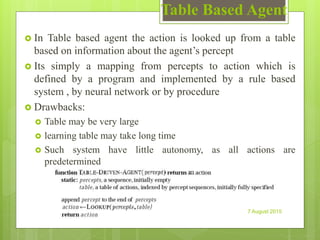Lecture 04 intelligent agents
- 2. Agent An Agent perceives its environment through sensors And acts upon the environment through actuators or effectors The complete set of input at a given time is called percept while can influence the actions of an agent An agent can be looked as a system which has goals and in order to implement them it maps percept sequences into actions Agents Performance measures: the success can be measured in various ways i.e. in terms of speed, efficiency, accuracy, quality, power usage, money etc. 7 August 2015
- 3. Ideal Rational Agent For each possible percept sequence ,an ideal rational agent should do whatever action is expected to maximize its performance measure, on the basis of the evidence provided by the percept sequence and whatever built in knowledge the agent has An Agent behavior can be based on both its experience and built in knowledge A system is autonomous to the extent that its behavior is determined by its own experience. Agent Program: A function that implements the agents mapping from percept to actions. This will run on some computing device which we call the architecture. Eg. Software Agents (Softbots) to fly a flight simulator etc. Agent =Architecture+ Program 7 August 2015
- 4. Properties of Task Environments 1. Fully Observable /Partially Observable 2. Deterministic /Stochastic 3. Episodic/Sequential 4. Static/dynamic 5. Discrete/Continuous 6. Single Agent /Multi Agent 7. Cooperative 8. Strategic 7 August 2015
- 5. Structure of Agent/Agent Architecture 1) Table Based Agents 2) Simple Reflex Agent/Percept Based Agents 3) Model Based Reflex Agents 4) Goal Based Agents 5) Utility Based Agents 6) Learning Agents 7 August 2015
- 6. Table Based Agent In Table based agent the action is looked up from a table based on information about the agent’s percept Its simply a mapping from percepts to action which is defined by a program and implemented by a rule based system , by neural network or by procedure Drawbacks: Table may be very large learning table may take long time Such system have little autonomy, as all actions are predetermined 7 August 2015
- 7. Simple Reflex Agent/Percept Based Agents It acts according to a rule whose condition matches the current state , as defined by the percept Such agents are designed based on the condition action rule First built a general purpose interprets for condition action rule and then to create rules set for specific task environments Eg. If (the car in front is braking) then (initiate braking) They are also termed as Reactive or Stimulus –Response agents Features: Efficient No internal representation for reasoning ,inference No strategic planning Percept based agents are not good for multiple opposing goals 7 August 2015
- 8. Model Based Reflex Agents It keeps track of the current state of the world using an internal model. It then chooses an action in the same way as the reflex agent It keeps track of the part of the world it can’t see now 7 August 2015
- 9. Goal Based Agent Such agents keeps track of the world state as well as a set of goals it is trying to achieve and chooses an action that will eventually leads to achievement of its goals Search and planning is needed to achieve agents goal Decision making involves future consideration as goal based 7 August 2015
- 10. Utility Based Agents If one world state is preferred t to another then it has higher utility for the agents A utility function maps a state (a sequence of states ) onto a real number, which describes associated degree of happiness. A complete specification of the utility function allows rational decision in two kinds of cases where goals are in adequate: It uses a model of the world along with the utility function That measures its preferences among state of the world. Conflicting Goals: i.e. only some of which can be achieved eg. Speed and safety Several goals: none o of which can be achieve with certainty. In such cases likelihood of success depends upon the importance of goals Then it chooses the actions that leads to the best expected utility where expected utility is computed by averaging overall possible outcome states, weighted by the probability of the outcome. 7 August 2015
- 11. Learning Agents Learning allows the agent to operate in initially unknown environments and to become more competent than its initial knowledge alone might allow A learning agent can be divided into four conceptual components: Learning element: responsible for making improvements Performance Element: responsible for selecting external actions Critic: the learning element uses feedback from the on how the performance element should be modified, to do better in future Problem Generator: responsible for suggesting actions that will lead to new and informative experience Eg. Taxi driving agents learns from feedback in form of reward and penalty. 7 August 2015










